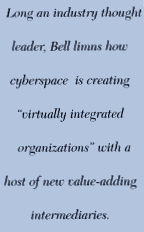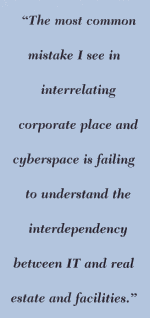
 Editor’s note: A former president of the International Development Research Council (IDRC), the world’s preeminent corporate real estate (CRE) association, Michael Bell (right) is a widely recognized industry leader. His Gartner Group (www.gartner.com) research focuses on workplace transformation and the virtual enterprise — specifically, the workplace impact of information technology (IT), including corporate strategy formulation, facilities deployment and configuration, and integrated infrastructure resources and support services.
Editor’s note: A former president of the International Development Research Council (IDRC), the world’s preeminent corporate real estate (CRE) association, Michael Bell (right) is a widely recognized industry leader. His Gartner Group (www.gartner.com) research focuses on workplace transformation and the virtual enterprise — specifically, the workplace impact of information technology (IT), including corporate strategy formulation, facilities deployment and configuration, and integrated infrastructure resources and support services.
Bell’s history includes serving as a managing director in PricewaterhouseCoopers’ CRE consulting services; heading Dun & Bradstreet CRE; and serving as a LaSalle Partners CRE consultant. He also spent 16 years in a series of executive positions at Xerox.
Long a champion of IT-enabled CRE processes, Bell has just begun working full-time from his home/virtual office in Noank, Conn., from where he’ll periodically contribute his insights.
Site Selection: You’ve been writing about and researching the virtual life for 10 years. So how is it in reality?
Michael Bell: I’m sitting here overlooking Fishers’ Island Sound; the sailboats are sailing by. I’m actually working longer and much more productively, but less stressfully. Working in Stamford (Conn.), I spent two hours a day commuting, 10 hours a week. So I’m actually adding a week to my work month. I’m at my workstation at 7:30 in the morning and I don’t break until 6:30 at night. And I don’t have the interruptions, which were costing me 20 percent of my time. Workwise, I’ve got a huge load, but I’d say my stress level has dropped by 50 percent. It’s wonderful.
SS: The virtual life, though, probably isn’t for everyone.
MB: Well, it obviously depends on the job. The nature of my job is that most of my calls are prescheduled with clients. I participate in four virtual teams, all working through the Net and/or the phone. Half my time I spend out on the road and the rest here. I might go to the office once every two weeks for a day.
But if you have a bunch of people who report, and need daily access, to you, this won’t work. But if you’re a global leader, and most of your constituents are dispersed out and about, then this works fine. What matters is the infrastructure.
SS: IT does allow us to very much “be there” without physically being there. But where does the notion of place fit in the interplay between cyberspace and workspace?
MB: Place is more important now than ever before. Face time is critical. There’s a deep-seated social need in all of us for maintaining relationships, and that requires physical proximity to read the cues and to build and maintain trust and rapport.
And there are practical reasons. That’s where business is transacted, where you have access to customers, suppliers and employers. So you need real portals, just as you need Web portals. Place is the ultimate portal in terms of having access to those resources.
SS: How does the notion of place, of corporate space, factor into the major dot-com shakeout we’re seeing?
Why E-Tailers Tanked
MB: So much of the e-tailers’ failure is that they haven’t had the physical infrastructure to fulfill, deliver and service customers. Customers want both the opportunity to order and have relationships with retailers online, but they also want to go to real places to pick up stuff, browse, compare and return. So with the disasters of the last two Christmases, customers have become very disenchanted with e-tailers that just don’t give them that kind of flexibility.
So the bricks and clicks — physical facilities and infrastructure combined with a cyberspace presence — is what we at Gartner Group see as the winning e-business formula.
But there are dot-coms that can be very successful. AOL just reported record earnings. But AOL also married up with a media company that has real newsmagazines and movies and parks and content.
SS: Most of the e-tailers started on the right note, with close physical knowledge-worker proximity. Where did their thinking about space go wrong?
MB: From talking with many e-tailers, it was critical for most that they had the basics, the infrastructure, to get a lot of very smart people together, literally cheek to jowl. But with these startups’ pace and intensity, trying to coordinate across time and space is really tough.
So as their businesses reached the next state, many were not smart enough to start diversifying their infrastructure. Many ran out of space, or their service levels dropped precipitously. It was sort of an un-virtuous circle: not planning ahead on how to begin to diversify and distribute their infrastructure as their businesses grew.
Some of the big technology companies are struggling with this as well. One from the beginning has maintained a strategy of adjacency, seeing it as a strategic advantage to keep all their engineers and software developers together. They’re now at a size where that strategy is really starting to pinch. It’s beginning to overwhelm the labor market. They’re going to have to start decentralizing. It’s an issue of critical mass. And that goes back to my theory that place is more important than ever. People want the Net’s flexibility and the power plus the power of place.
SS: But there’s a counter trend to the role of place: the small “virtual companies” that keep popping up, with no real corporate space and most employees working at home. What do you make of that trend?
MB: There’s a phenomenon that’s developing, and I don’t know if it will last, that’s called “built to flip.” Rather than built to last, many of these startups are built with the explicit intent of being acquired. So the startup is done virtually, and then they look for a buyer. And that’s not a bad entrepreneurial strategy.
That poses another question. Rather than pour a ton of money into R&D, why not keep an eye out for all these new business models and pick them off in their formative stages before they get too expensive? Cisco Systems does this brilliantly. And many of the guys who began those startups stay because Cisco has such an amazingly positive culture around that model.
From Vertical to Virtual
SS: But can virtual companies endure?
MB: We’ve done a lot of research on that, which we call the “virtually integrated enterprise.”
To put that notion in perspective, go back to the famous Ford Model-T plant in Detroit, where everything was controlled within the boundaries of the enterprise. But with the network-based economy, vertical integration is beginning to yield to virtual integration; much of the value chain can be virtually parsed out to third-party entities that have the core competencies in those areas of the value chain. Companies like Ford, GM and Chrysler are beginning to decompose their value chains, coordinating all this through an intranet/extranet platform.
That’s a virtual enterprise. You’ve gone from a castle mentality to a very horizontal model.
So the virtual enterprise is very much becoming the prominent model. But notice that they’re really a combination of traditional businesses with real offices, factories and people, plus a whole series of virtually plugged-in players. That allows the traditional businesses to concentrate on core competencies, and it can also help reduce real estate requirements.
SS: Is there one thing that struck you in your research on the connection between physical space and cyberspace?
MB: Yes. If you step back and look at the purposes of the real estate and facilities function and the IT organization, the overlap in terms of mission is almost complete.
Both IT and real estate projects are similar in many respects. They require a lot of business alignment, take a lot of time to plan and execute, and the dollar amounts are very high. They follow an asset lifecycle in terms of planning, acquisition, maintenance and retirement disposition. They both manage services and subcontracts. Do those terms sound familiar?
It’s the same managerial task with a different domain knowledge. Certainly IT has its black art and all of its complexity. But when it comes to putting that complexity into service, the challenges are almost identical, with a huge amount of synergies.
For example, 65 to 75 percent of IT spending is for infrastructure: the equipment, productivity applications, cabling, servers, routers and all the associated applications that drive communications and connectivity. It’s all about productivity. Similarly, the real estate and facilities’ role is to provide the infrastructure for the work, though more around occupancy rather than connectivity.
We’ve redefined it as a bundle of services. The new workplace is a service offering combining occupancy services, connectivity services and other support.
We see a real convergence around the service mantra. Cisco, Proctor & Gamble (P&G) Sun, many of the Big Five and a host of other companies are beginning to create integrated workplace service organizations. P&G, for example, has created a Workplace Services organization composed of all of IT and real estate and facilities. Its mission is to support employees wherever they are: in the office, a train, a plane or wherever.
SS: You haven’t mentioned human resources in that infrastructure integration.
MB: Many of the people we talk to say HR is sort of a no-show. We don’t know why, and we think it will change. The HR people should certainly have a huge stake in this.
SS: In infrastructure integration’s early stages, there was huge jockeying for position as to which function would lead. At this point, does it matter?
MB: No. We just had a meeting in Boston. A lot of the leaders in that group were from IT-centric businesses, and the rest were more traditional real estate and facilities folks. But the agenda was the same: flexibility, predictability, user satisfaction, and the shift in power from function to people.
And the employees aren’t interested in whether it’s a real estate guy or an IT guy. It’s like a hotel: food, bed or whatever, you just want service.
More and more I think this function’s leaders will actually come from the business units.
New Intermediaries Emerge
 SS: Do you see a common knowledge gap in the approach to the interrelationship of corporate place and cyberspace?
SS: Do you see a common knowledge gap in the approach to the interrelationship of corporate place and cyberspace?
MB: I think the most common mistake is failing to understand the interdependency between IT and real estate and facilities.
For example, consider when IT people are doing their planning for, say, ERP systems that will eliminate a whole slew of separate administrative operations. Are they considering that perhaps those systems could enable consolidating 40 functions into one call center in Florida, eliminating 3 million sq. ft. (270,000 sq. m.) of office space? Is that factored into the ERP investment?
Similarly, when real estate execs do long-term demand planning, have they factored in that technology may mean downsizing or altogether eliminating certain facilities?
The mistake is not planning holistically. If they were to plan horizontally, iteratively, around some of these scenarios, our research suggests huge opportunities on both sides. But they plan in isolation. They still come back to their comfort zones, become very defensive and parochial, and their plans are siloed.
SS: Many analysts predicted a lot of Web-driven real estate disintermediation. Will that happen?
MB: It’s completely not going to happen. First of all, the broker will be alive and well and an important player. But they will morph. To be a just purveyor of information, forget it, that’s a losing proposition. But brokers who are much more value-added advisors — providing not just data, but knowledge and advice — will be very prosperous.
Our sense is that there is a new intermediary beginning to emerge, and the power is in integration, providing real estate service in conjunction with communications and IT service.
Take Regus, the instant office provider. More and more companies are engaging Regus as a part of their portfolio. Regus offers offices that are furnished, serviced, connected, with virtual, private networks through a network of 600 to 700 offices worldwide. They sit between the user organization and all the accouterments of the facility/IT industry.
And the workplace services groups at places like P&G and Sun are, in fact, new intermediaries. They sit between all of the outsourced providers and the user organizations. They’re very Web-enabled, bricks and clicks, bringing the disparate parts into a coherent, efficient delivery to users.
What’s the Model?
SS: How do you see the process of Web-enabling CRE unfolding?
MB: The biggest single application in corporate real estate will be Web-ifying all the processes. It’s happening very quickly. Companies like Nortel, Cisco and Fidelity are well into Web-enabling their real estate, and a host of other companies are in the planning stage.
It’s just so logical. Imagine if you’re an employee and you have to make five phone calls just to move your office, plus the labor and all the internal coordination that’s involved. Now imagine the time and hassle saved if you can do that with one click of a mouse, and it’s booked and dispatched to all the different players. The self-service factor is very important in all this.
SS: Is one predominant model emerging for how CRE operations Web-ify their processes?
MB: Some applications will be developed internally, others by service providers.
For example, Cushman & Wakefield, with whom Gartner Group has just entered into a strategic alliance, has its e-real estate application. That system has all the steps right there: templates and forms, everything you need — strategic planning, site selection, design, lease negotiations, construction management documentation, all the way to occupancy and post-occupancy.
But it won’t be one size fits all. There’s a lot of customization in this game. It depends on where you are in your lifecycle, the nature of your real estate portfolio and your business.
But it will be Web-ified. No question. The big payoff is in phenomenal operational efficiencies. Jack Welch at GE believes it will produce 20 percent in cost, efficiency and productivity savings.
It’s definitely gonna happen.

